Carbon Nanotube Film/Silicon Heterojunction Photodetector for New Cutting-Edge Technological Devices
Abstract
Featured Application
Abstract
1. Introduction
2. Materials and Methods
2.1. SWCNT Film Fabrication
2.2. SWCNT Film Transfer onto a Substrate
2.3. SWCNT Film Optoelectronic Properties Characterization and Control
2.4. Fabrication of the NSH PD
2.5. Set-Up for Experimental Characterization of SWCNT Film and NSH PD
3. Results
3.1. Photovoltaic Configuration
3.2. Photoconductive Configuration
4. Conclusions
Author Contributions
Funding
Institutional Review Board Statement
Informed Consent Statement
Data Availability Statement
Acknowledgments
Conflicts of Interest
References
- Saito, R.; Dresselhaus, G.; Dresselhaus, M.S. Physical Properties of Carbon Nanotubes; Imperial College Press: London, UK, 1998; p. xii. 259p. [Google Scholar]
- Tans, S.J.; Devoret, M.H.; Dai, H.J.; Thess, A.; Smalley, R.E.; Geerligs, L.J.; Dekker, C. Individual single-wall carbon nanotubes as quantum wires. Nature 1997, 386, 474–477. [Google Scholar] [CrossRef]
- Dekker, C. Carbon nanotubes as molecular quantum wires. Phys. Today 1999, 52, 22–28. [Google Scholar] [CrossRef]
- Javey, A.; Guo, J.; Wang, Q.; Lundstrom, M.; Dai, H.J. Ballistic carbon nanotube field-effect transistors. Nature 2003, 424, 654–657. [Google Scholar] [CrossRef] [PubMed]
- Jorio, A.; Dresselhaus, G.; Dresselhaus, M.S. Carbon Nanotubes: Advanced Topics in the Synthesis, Structure, Properties, and Applications; Springer: Berlin, Germany; New York, NY, USA, 2008; p. xxiv. 720p. [Google Scholar]
- Kaiser, A.B. Electronic transport properties of conducting polymers and carbon nanotubes. Rep. Prog. Phys. 2001, 64, 1–49. [Google Scholar] [CrossRef]
- De Nicola, F.; Salvato, M.; Cirillo, C.; Crivellari, M.; Boscardin, M.; Passacantando, M.; Nardone, M.; De Matteis, F.; Motta, N.; De Crescenzi, M.; et al. 100% internal quantum efficiency in polychiral single-walled carbon nanotube bulk heterojunction/silicon solar cells. Carbon 2017, 114, 402–410. [Google Scholar] [CrossRef]
- De Nicola, F.; Salvato, M.; Cirillo, C.; Crivellari, M.; Boscardin, M.; Scarselli, M.; Nanni, F.; Cacciotti, I.; De Crescenzi, M.; Castrucci, P. Record efficiency of air-stable multi-walled carbon nanotube/silicon solar cells. Carbon 2016, 101, 226–234. [Google Scholar] [CrossRef]
- Jia, Y.; Li, P.X.; Wei, J.Q.; Cao, A.Y.; Wang, K.L.; Li, C.L.; Zhuang, D.M.; Zhu, H.W.; Wu, D.H. Carbon nanotube films by filtration for nanotube-silicon heterojunction solar cells. Mater. Res. Bull. 2010, 45, 1401–1405. [Google Scholar] [CrossRef]
- Castrucci, P. Carbon nanotube/silicon hybrid heterojunctions for photovoltaic devices. Adv. Nano Res. 2014, 2, 23–56. [Google Scholar] [CrossRef]
- Tune, D.D.; Flavel, B.S. Advances in Carbon Nanotube-Silicon Heterojunction Solar Cells. Adv. Energy Mater. 2018, 8, 1703241. [Google Scholar] [CrossRef]
- Tune, D.D.; Mallik, N.; Fornasier, H.; Flavel, B.S. Breakthrough Carbon Nanotube-Silicon Heterojunction Solar Cells. Adv. Energy Mater. 2020, 10, 1903261. [Google Scholar] [CrossRef]
- Tune, D.D.; Shirae, H.; Lami, V.; Headrick, R.J.; Pasquali, M.; Vaynzof, Y.; Noda, S.; Hobbie, E.K.; Flavel, B.S. Stability of Chemically Doped Nanotube-Silicon Heterojunction Solar Cells: Role of Oxides at the Carbon-Silicon Interface. ACS Appl. Energy Mater. 2019, 2, 5925–5932. [Google Scholar] [CrossRef]
- Rigoni, F.; Pintossi, C.; Drera, G.; Pagliara, S.; Lanti, G.; Castrucci, P.; De Crescenzi, M.; Sangaletti, L. A cross-functional nanostructured platform based on carbon nanotube-Si hybrid junctions: Where photon harvesting meets gas sensing. Sci. Rep. 2017, 7, 44413. [Google Scholar] [CrossRef] [PubMed]
- Zeng, Q.S.; Wang, S.; Yang, L.J.; Wang, Z.X.; Pei, T.; Zhang, Z.Y.; Peng, L.M.; Zhou, W.W.; Liu, J.; Zhou, W.Y.; et al. Carbon nanotube arrays based high-performance infrared photodetector [Invited]. Opt. Mater. Express 2012, 2, 839–848. [Google Scholar] [CrossRef]
- Ambrosio, A.; Aramo, C.; Battiston, R.; Castrucci, P.; Cilmo, M.; De Crescenzi, M.; Fiandrini, E.; Grossi, V.; Guarino, F.; Maddalena, P.; et al. Innovative carbon nanotube-silicon large area photodetector. J. Instrum. 2012, 7, 08013. [Google Scholar] [CrossRef]
- Xie, Y.; Gong, M.G.; Shastry, T.A.; Lohrman, J.; Hersam, M.C.; Ren, S.Q. Broad-Spectral-Response Nanocarbon Bulk-Heterojunction Excitonic Photodetectors. Adv. Mater. 2013, 25, 3433–3437. [Google Scholar] [CrossRef] [PubMed]
- Zhang, T.F.; Li, Z.P.; Wang, J.Z.; Kong, W.Y.; Wu, G.A.; Zheng, Y.Z.; Zhao, Y.W.; Yao, E.X.; Zhuang, N.X.; Luo, L.B. Broadband photodetector based on carbon nanotube thin film/single layer graphene Schottky junction. Sci. Rep. 2016, 6, 38569. [Google Scholar] [CrossRef]
- Salvato, M.; Scagliotti, M.; De Crescenzi, M.; Crivellari, M.; Prosposito, P.; Cacciotti, I.; Castrucci, P. Single walled carbon nanotube/Si heterojunctions for high responsivity photodetectors. Nanotechnology 2017, 28, 435201. [Google Scholar] [CrossRef] [PubMed]
- Scagliotti, M.; Salvato, M.; De Crescenzi, M.; Boscardin, M.; Castrucci, P. Influence of the contact geometry on single-walled carbon nanotube/Si photodetector response. Appl. Nanosci. 2018, 8, 1053–1058. [Google Scholar] [CrossRef]
- Salvato, M.; Scagliotti, M.; De Crescenzi, M.; Crivellari, M.; Messi, R.; Castrucci, P. Increasing Efficiency in Single-Walled Carbon Nanotube/n-Si Photodetectors by Voltage Doping. IEEE Trans. Nanotechnol. 2018, 17, 837–840. [Google Scholar] [CrossRef]
- Salvato, M.; Scagliotti, M.; De Crescenzi, M.; Boscardin, M.; Attanasio, C.; Avallone, G.; Cirillo, C.; Prosposito, P.; De Matteis, F.; Messi, R.; et al. Time response in carbon nanotube/Si based photodetectors. Sens. Actuators A Phys. 2019, 292, 71–76. [Google Scholar] [CrossRef]
- Aramo, C.; Ambrosio, M.; Bonavolonta, C.; Boscardin, M.; Crivellari, M.; de Lisio, C.; Grossi, V.; Maddalena, P.; Passacantando, M.; Valentino, M. Large area CNT-Si heterojunction for photodetection. Nucl. Instrum. Meth. A 2017, 845, 12–15. [Google Scholar] [CrossRef]
- Bonavolonta, C.; Aramo, C.; Ambrosio, M.; Boscardin, M.; Consiglio, L.; Crivellari, M.; Fiandrini, E.; Passacantando, M.; Santucci, S.; Valentino, M. UV photo-responsivity of a large-area MWCNT-Si photodetector operated at cryogenic temperature. Eur. Phys. J. Plus 2018, 133, 1–6. [Google Scholar] [CrossRef]
- Kato, H.; Nakamura, A.; Horie, M. Behavior of surfactants in aqueous dispersions of single-walled carbon nanotubes. RSC Adv. 2014, 4, 2129–2136. [Google Scholar] [CrossRef]
- Kumar, C.S.S.R. UV-VIS and Photoluminescence Spectroscopy for Nanomaterials Characterization; Springer: Berlin/Heidelberg, Germany, 2013. [Google Scholar]
- De Nicola, F.; Pintossi, C.; Nanni, F.; Cacciotti, I.; Scarselli, M.; Drera, G.; Pagliara, S.; Sangaletti, L.; De Crescenzi, M.; Castrucci, P. Controlling the thickness of carbon nanotube random network films by the estimation of the absorption coefficient. Carbon 2015, 95, 28–33. [Google Scholar] [CrossRef]
- Bagolini, A.; Boscardin, M.; Conci, P.; Crivellari, M.; Giacomini, G.; Mattedi, F.; Piemonte, C.; Ronchin, S.; Zorzi, N.; Benkechkache, M.A.; et al. Micromachined silicon radiation sensors—Part 2: Fabrication technologies. In Proceedings of the 2015 XVIII AISEM Annual Conference, Trento, Italy, 3–5 February 2015; pp. 1–4. [Google Scholar]
- Catone, D.; Di Mario, L.; Martelli, F.; O’Keeffe, P.; Paladini, A.; Cresi, J.S.P.; Sivan, A.K.; Tian, L.; Toschi, F.; Turchini, S. Ultrafast optical spectroscopy of semiconducting and plasmonic nanostructures and their hybrids. Nanotechnology 2020, 32, 025703. [Google Scholar] [CrossRef] [PubMed]
- Rossi, G.; Pasquini, L.; Catone, D.; Piccioni, A.; Patelli, N.; Paladini, A.; Molinari, A.; Caramori, S.; O’Keeffe, P.; Boscherini, F. Charge carrier dynamics and visible light photocatalysis in vanadium-doped TiO2 nanoparticles. Appl. Catal. B Environ. 2018, 237, 603–612. [Google Scholar] [CrossRef]
- Del Gobbo, S.; Castrucci, P.; Fedele, S.; Riele, L.; Convertino, A.; Morbidoni, M.; De Nicola, F.; Scarselli, M.; Camilli, L.; De Crescenzi, M. Silicon spectral response extension through single wall carbon nanotubes in hybrid solar cells. J. Mater. Chem. C 2013, 1, 6752–6758. [Google Scholar] [CrossRef]
- Sze, S.M. Semiconductor Devices: Physics and Technology; John Wiley & Sons: Hoboken, NJ, USA, 2008. [Google Scholar]
- Bindl, D.J.; Shea, M.J.; Arnold, M.S. Enhancing extraction of photogenerated excitons from semiconducting carbon nanotube films as photocurrent. Chem. Phys. 2013, 413, 29–34. [Google Scholar] [CrossRef]
- Barazzouk, S.; Hotchandani, S.; Vinodgopal, K.; Kamat, P.V. Single-Wall Carbon Nanotube Films for Photocurrent Generation. A Prompt Response to Visible-Light Irradiation. J. Phys. Chem. B 2004, 108, 17015–17018. [Google Scholar] [CrossRef]
- Kataura, H.; Kumazawa, Y.; Maniwa, Y.; Umezu, I.; Suzuki, S.; Ohtsuka, Y.; Achiba, Y. Optical properties of single-wall carbon nanotubes. Synth. Met. 1999, 103, 2555–2558. [Google Scholar] [CrossRef]
- Scagliotti, M.; Salvato, M.; De Crescenzi, M.; Kovalchuk, N.G.; Komissarov, I.V.; Prischepa, S.L.; Catone, D.; Di Mario, L.; Boscardin, M.; Crivellari, M.; et al. Femtosecond light pulse response of photodetectors based on Graphene/n-Si heterojunctions. Carbon 2019, 152, 643–651. [Google Scholar] [CrossRef]
- Hamamatsu Handbook. Available online: https://www.hamamatsu.com/sp/ssd/doc_en.html (accessed on 10 October 2020).
- Martel, R.; Schmidt, T.; Shea, H.R.; Hertel, T.; Avouris, P. Single- and multi-wall carbon nanotube field-effect transistors. Appl. Phys. Lett. 1998, 73, 2447–2449. [Google Scholar] [CrossRef]
- Nelson, J.A. The Physics of Solar Cells; Imperial College Press: London, UK, 2003. [Google Scholar]
- Scagliotti, M.; Salvato, M.; De Crescenzi, M.; Castrucci, P.; Kovalchuk, N.G.; Komissarov, I.V.; Prischepa, S.L.; Catone, D.; Di Mario, L.; Boscardin, M.; et al. 2D Carbon Material/Silicon Heterojunctions for Fast Response Self-Powered Photodetector. Int. J. Nanosci. 2019, 18, 1940088. [Google Scholar] [CrossRef]
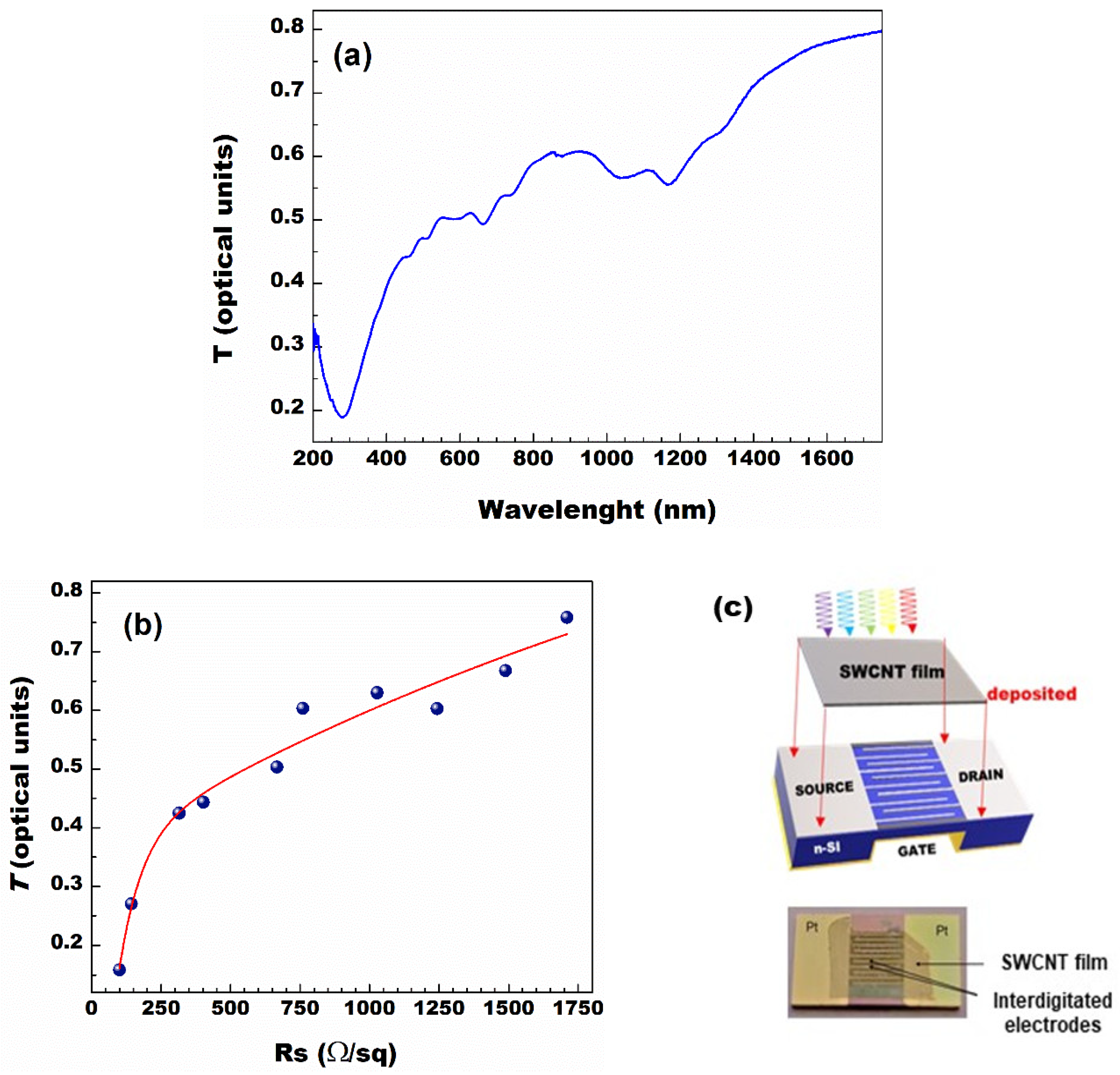
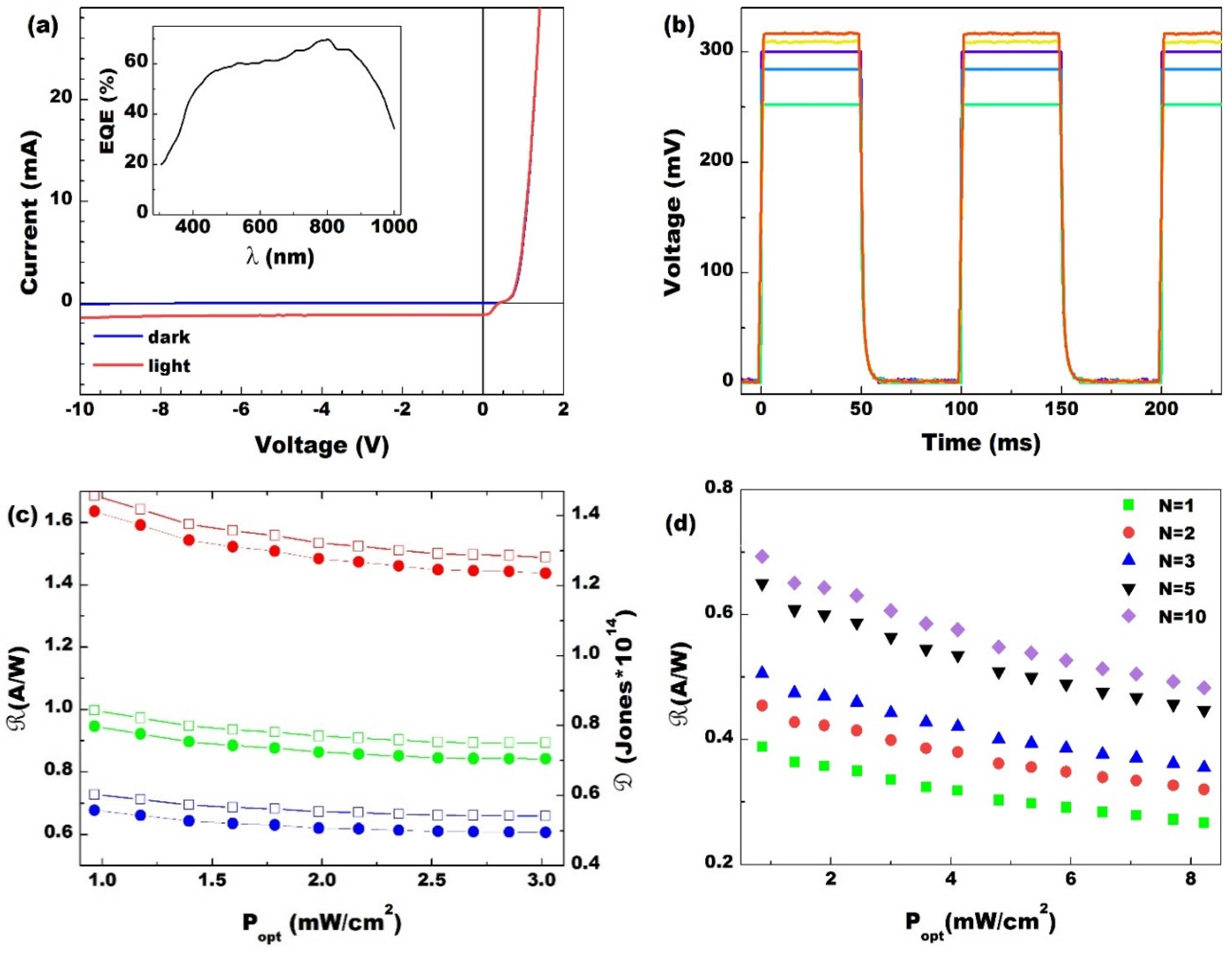
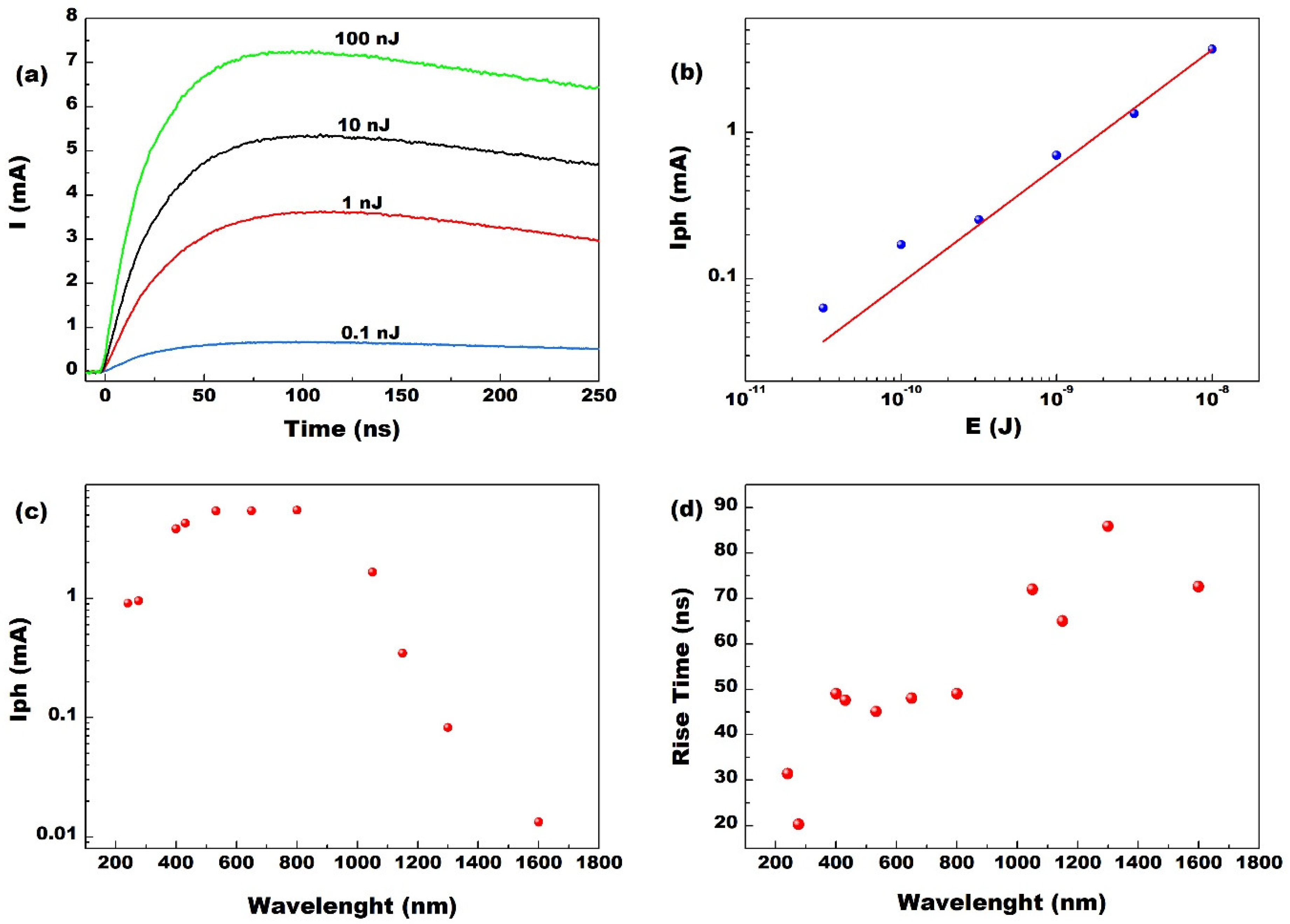
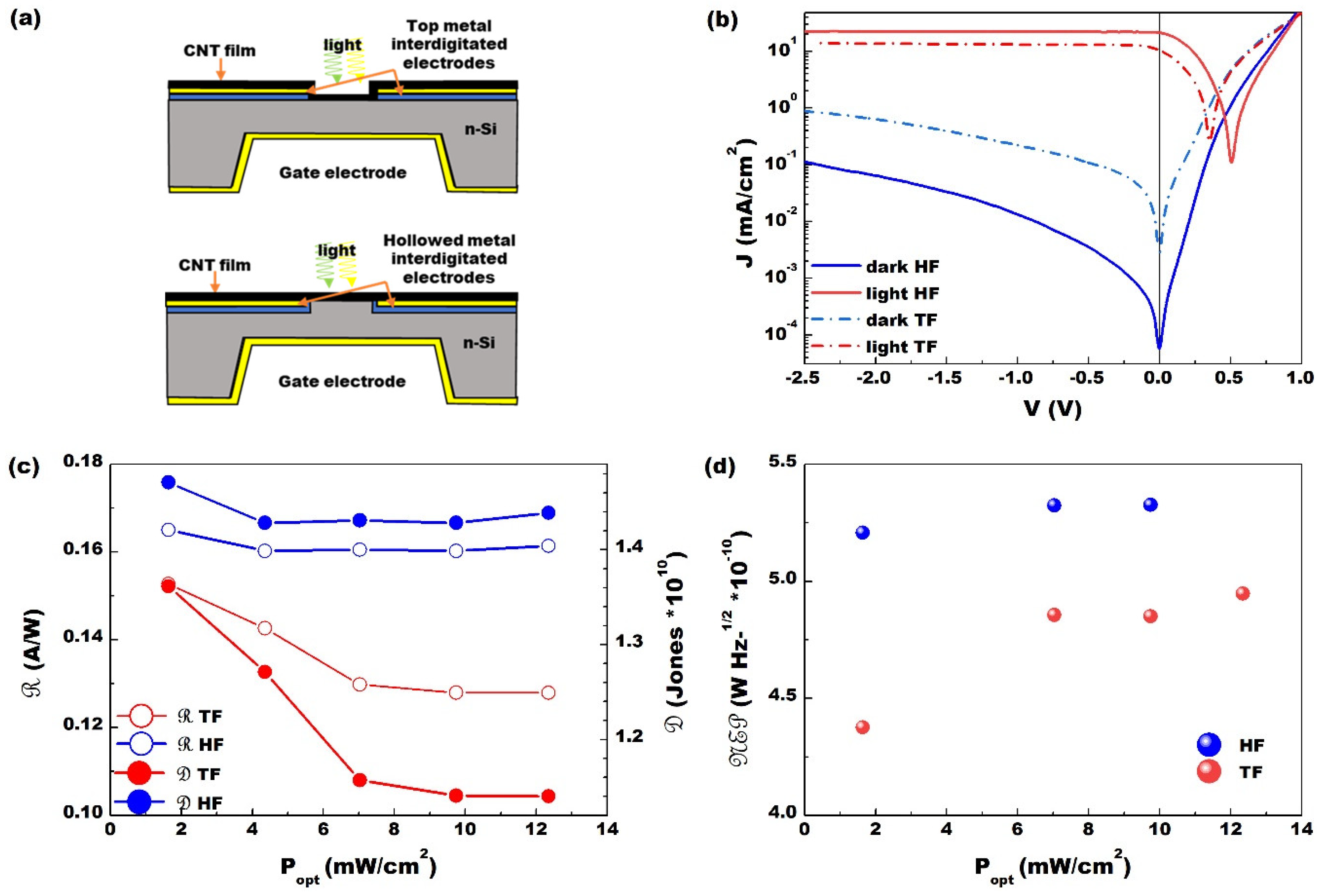
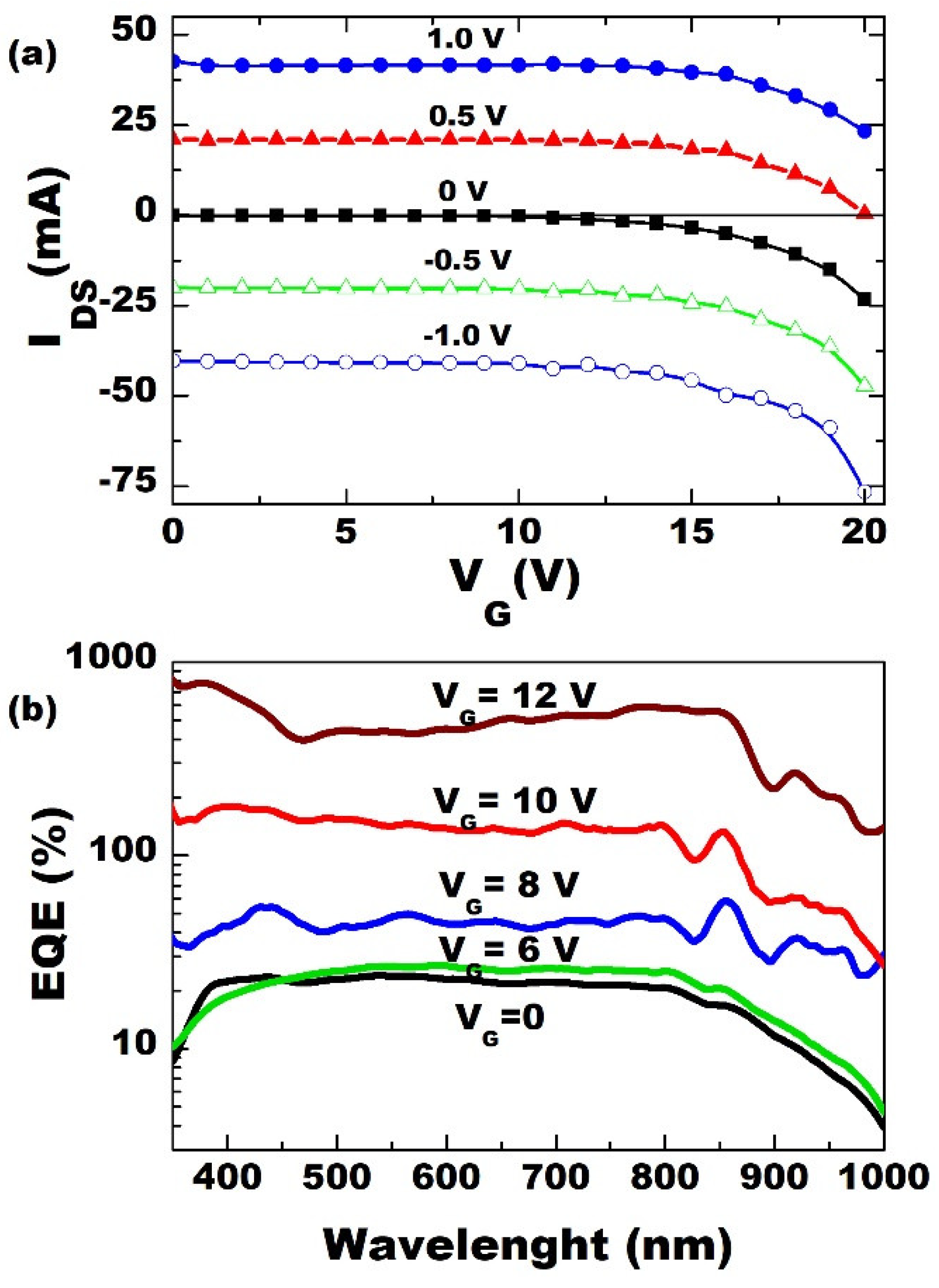
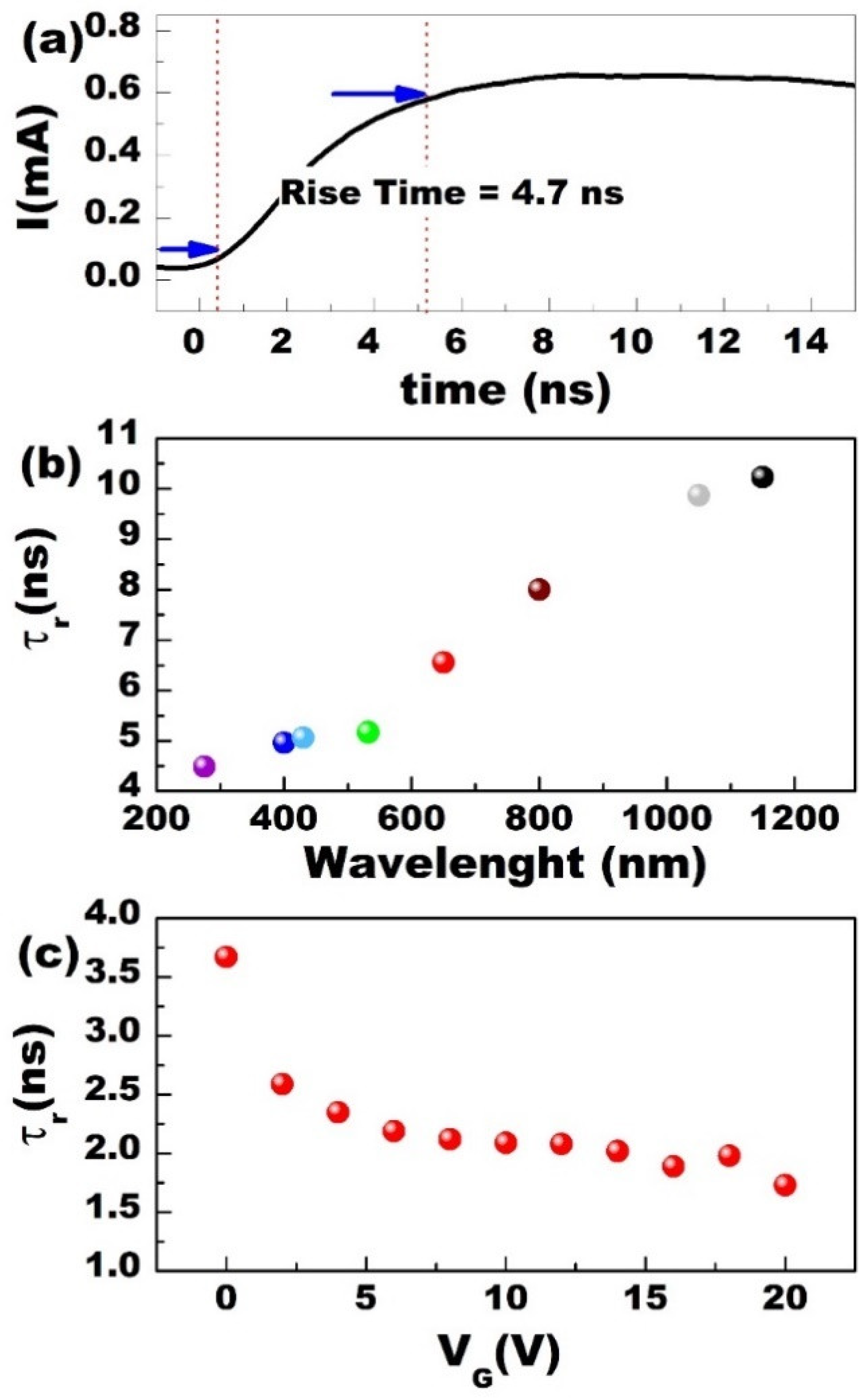
Publisher’s Note: MDPI stays neutral with regard to jurisdictional claims in published maps and institutional affiliations. |
© 2021 by the authors. Licensee MDPI, Basel, Switzerland. This article is an open access article distributed under the terms and conditions of the Creative Commons Attribution (CC BY) license (http://creativecommons.org/licenses/by/4.0/).
Share and Cite
Scagliotti, M.; Salvato, M.; Frezza, F.; Catone, D.; Di Mario, L.; Boscardin, M.; De Crescenzi, M.; Castrucci, P. Carbon Nanotube Film/Silicon Heterojunction Photodetector for New Cutting-Edge Technological Devices. Appl. Sci. 2021, 11, 606. https://doi.org/10.3390/app11020606
Scagliotti M, Salvato M, Frezza F, Catone D, Di Mario L, Boscardin M, De Crescenzi M, Castrucci P. Carbon Nanotube Film/Silicon Heterojunction Photodetector for New Cutting-Edge Technological Devices. Applied Sciences. 2021; 11(2):606. https://doi.org/10.3390/app11020606
Chicago/Turabian StyleScagliotti, Mattia, Matteo Salvato, Federico Frezza, Daniele Catone, Lorenzo Di Mario, Maurizio Boscardin, Maurizio De Crescenzi, and Paola Castrucci. 2021. "Carbon Nanotube Film/Silicon Heterojunction Photodetector for New Cutting-Edge Technological Devices" Applied Sciences 11, no. 2: 606. https://doi.org/10.3390/app11020606
APA StyleScagliotti, M., Salvato, M., Frezza, F., Catone, D., Di Mario, L., Boscardin, M., De Crescenzi, M., & Castrucci, P. (2021). Carbon Nanotube Film/Silicon Heterojunction Photodetector for New Cutting-Edge Technological Devices. Applied Sciences, 11(2), 606. https://doi.org/10.3390/app11020606





